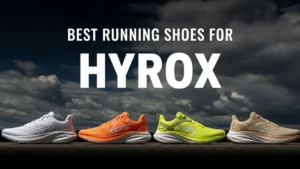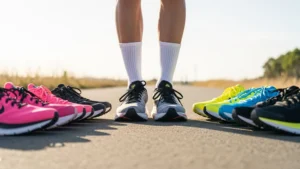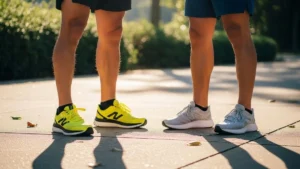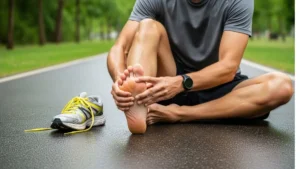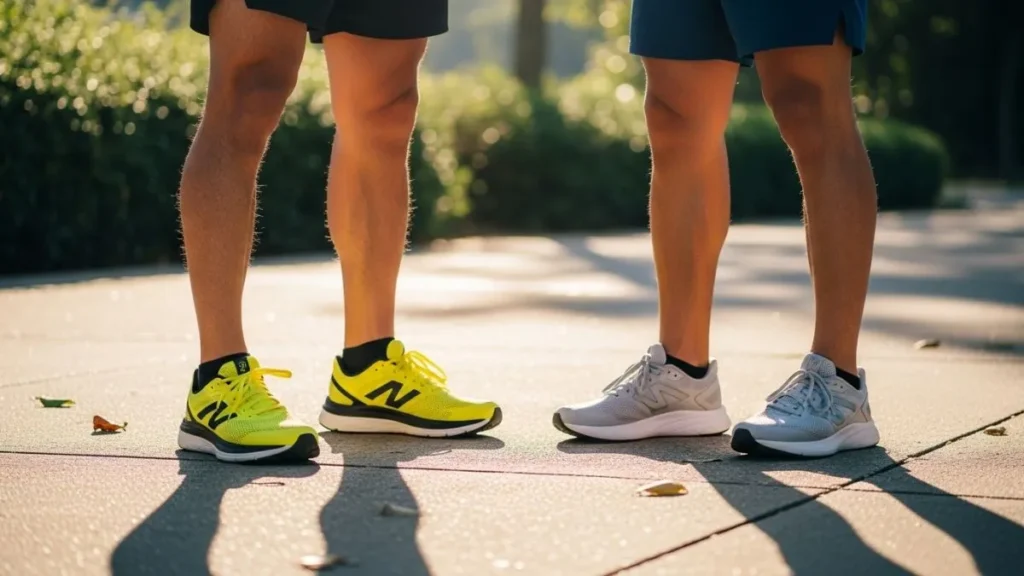
Real Questions Runners Ask
What are the best running shoes for arch support?
The best running shoes for arch support are the Brooks Adrenaline GTS 23, ASICS Gel-Kayano 31, and HOKA Gaviota 5. They stand out for their firm midsoles, stable cushioning, and reliable heel-to-toe balance. These features keep the arches supported mile after mile without adding bulk or stiffness. When I test shoes, I look for ones that feel supportive right away. You shouldn’t need a “break-in period.” The shoe should cradle your arch, not press against it. If you can jog a few steps and feel your midfoot held steady without pain, you’ve found a good match.
Why does arch support matter for comfort?
Arch support matters because it spreads pressure evenly and reduces foot strain during long runs. Without proper support, your feet absorb more impact, which can lead to pain in your heels, knees, or hips. It’s not just about comfort it’s about keeping your stride efficient and pain-free. Think of your arch like a bridge. If it’s weak, every step feels like a collapse. Good arch support acts like sturdy pillars that keep your bridge strong and balanced. That’s why runners with even mild discomfort often feel instant relief after switching to supportive shoes.
How do I know if I need arch support shoes?
You likely need arch support shoes if you often feel foot fatigue, arch pain, or soreness in your ankles or heels after running. These are the first red flags that your current shoes don’t match your foot’s natural shape. A simple way to test it is the wet footprint test. Step onto a piece of paper after wetting your foot. If you see a flat print, you have low arches and need extra support. If you see a narrow middle, your arches are high and need softer cushioning to fill the gap. Your running style also reveals clues. If your feet roll inward (overpronation) or outward (supination), arch support can help realign your stride and prevent injuries.
Are arch support shoes better for flat feet or high arches?
Arch support shoes help both flat feet and high arches, but for different reasons. Flat feet need firmer midsoles that lift the arch and prevent the foot from collapsing inward. High arches, on the other hand, need softer cushioning that absorbs impact and fills the arch gap. Think of it this way if your foot is flat, you need structure; if your arch is high, you need shock absorption. Both designs aim for balance, but the build of the shoe differs.
For example: Brooks Adrenaline GTS 23 and Saucony Guide 17 suit flat-footed runners, while HOKA Clifton 9 and ASICS Gel-Nimbus 26 are great for high arches. Knowing which side you fall on makes all the difference in comfort and injury prevention.
What Makes a Running Shoe Great for Arch Support
The Anatomy of Good Arch Support
Good arch support starts with a firm midfoot base that keeps your foot stable without feeling stiff. It’s a balance between structure and comfort too soft and your foot sinks; too hard and your stride feels restricted. The sweet spot lies in supportive contouring that mirrors your arch’s natural curve. A solid arch area usually includes a raised midsole section made from high-density foam or TPU (thermoplastic polyurethane).
This piece helps distribute pressure evenly from heel to toe and stops the foot from collapsing inward during motion. You’ll also notice a heel counter, the stiff part wrapping your heel, working hand-in-hand with the arch to lock your foot in place. Think of it like a well-built suspension bridge. Each step applies force, and the structure underneath absorbs and spreads that pressure. Without that foundation, you’d feel every bump and dip on the road.
Cushioning and Midsole Structure
The midsole is the heart of arch comfort it’s where cushioning and support meet. Shoes with multiple foam densities or blended materials often give the most reliable balance. EVA foams provide softness, while TPU or medial posts deliver structure and control.
For example: The ASICS Gel-Kayano 31 uses a dual-density midsole that cushions impact while preventing inward roll. The HOKA Gaviota 5 adds an oversized rocker design that keeps transitions smooth for tired arches. These designs don’t just pad your step they guide your stride naturally.
The goal is to support movement without fighting it. A good midsole should compress slightly with each stride, then rebound fast enough to keep momentum. Too much softness and your foot wobbles; too much firmness and your legs tire early.
Importance of Fit and Flexibility
Even the best arch support fails if the shoe doesn’t fit right. A snug midfoot hold keeps your arches secure and aligned, while a flexible forefoot allows your toes to move freely. When these two elements work together, you get comfort that feels natural, not forced. Always check that the shoe hugs the middle of your foot without pinching. The arch area should make gentle contact not press too hard. Flexibility at the ball of the foot helps maintain a smooth toe-off, which keeps the arch from working overtime.
A simple test: Hold the shoe at the heel and toe, then bend it. It should flex at the forefoot, not in the middle. If it folds too easily in the center, it lacks the structure to support your arch over long distances.
Signs You Need Better Arch Support
Pain in Arches or Heels
Persistent pain in your arches or heels is the clearest sign you need better arch support. This pain often shows up during or after runs, especially in the first few steps of the morning. It can feel like a sharp sting under the heel or a dull ache across the midfoot. That discomfort happens when your shoes fail to hold your arch in a neutral position. Each stride stretches the plantar fascia the band running under your foot until it becomes inflamed. Over time, this strain can lead to plantar fasciitis, one of the most common runner injuries. If you’re feeling that pain daily, don’t ignore it. Switching to shoes with stronger midsoles and reinforced arch zones can often stop the issue before it worsens.
Uneven Shoe Wear Patterns
Uneven wear on your soles means your arches aren’t getting balanced support. If the inside edge of your shoes wears faster, you’re likely overpronating your arches collapse inward. If the outer edges wear faster, you might be supinating rolling outward. Both patterns show your shoe isn’t matching your gait. It’s like driving a car with unbalanced tires one side takes more pressure until something gives out. Checking your old shoes can reveal this problem before your feet do. Replacing your pair with one made for your gait type can stop the wear imbalance. Brands like Brooks, Saucony, and ASICS make stability models for overpronators and neutral models for even wear.
Tired Feet After Short Runs
If your feet feel drained after short runs, your arches are likely overworking to keep balance. Instead of the shoe absorbing impact, your foot muscles take the hit. That leads to fatigue, soreness, or even calf tightness after just a few miles. Proper arch support acts like a spring it stores energy on impact and returns it as you lift off. Without it, your body uses more effort for the same distance, which slows you down and tires you out faster. You’ll notice the difference immediately with the right shoes. Supportive midsoles make your stride feel lighter, as if your feet finally got some backup.
Best Running Shoes With Great Arch Support
Here are seven top-performing models that deliver strong arch support, along with short specs, features and benefits for each.
Brooks Adrenaline GTS 23
The Adrenaline GTS 23 is a stable daily trainer built for runners who need structured support in the midfoot. It features a 12 mm drop with generous heel cushion (≈ 36 mm) and fuller mid-foot support.
Key features: Its GuideRails sidewalls help contain excess motion, and the firm midsole holds the arch in place.
Benefit: If your arches collapse or you overpronate, this shoe gives you a firm platform that stabilises your foot without making you feel locked.
ASICS Gel-Kayano 31
This model focuses on “adaptive stability” with its 4D Guidance System and wide base design through the midfoot. Specs include a medium drop (~10 mm) and a plush midsole foam combo. It holds the arch area higher than some prior versions, meaning your foot sits more supported in the mid-foot region.
Benefit: Ideal for runners who want arch support plus cushioning, especially on moderate distance runs.
Saucony Guide 17
The Guide 17 carries on Saucony’s support line with firmer foam under the arch, designed for mild overpronation. It blends mid-level cushioning with a stabilising mid-foot plate.
Benefit: A good mix of comfort and structural arch support for everyday training runs.
HOKA Gaviota 5
Gaviota 5 is HOKA’s max-support model with wide base and a dual-density midsole built for serious stability. It offers strong arch support via firm medial foam and a broad mid-foot platform.
Benefit: Excellent if you have high arches or need a very stable ride for long miles.
New Balance 860v14
The 860v14 is a more traditional stability/training shoe. It features a firm medial post and structured mid-foot designed for overpronators and runners needing extra arch control.
Benefit: Reliable, tried-and-true support for arch and mid-foot alignment.
Nike Structure 25
Nike’s Structure 25 integrates a dual-density foam and a stabilising plate beneath the arch to keep your stride stable.
Benefit: Good choice for runners who want mainstream styling plus effective arch support.
On Cloudstratus 3
Cloudstratus 3 uses a “dual-layer CloudTec” midsole which gives cushioning plus arch-area integrity. While it is more neutral than some full stability shoes, it has a firmer mid-foot section.
Benefit: A less obtrusive support option if you have mid-arches and want more comfort than aggressive stability.
Short Comparison Table
| Shoe Model | Stability Level | Cushioning Level | Best For Arch Height |
| Brooks Adrenaline GTS 23 | Moderate to High | Medium to High | Flat to Normal arches |
| ASICS Gel-Kayano 31 | High | High | Flat to Normal arches |
| Saucony Guide 17 | Moderate | Medium | Normal arches |
| HOKA Gaviota 5 | High | Medium to High | High arches |
| New Balance 860v14 | Moderate | Medium | Flat to Normal arches |
| Nike Structure 25 | Moderate | Medium | Normal arches |
| On Cloudstratus 3 | Low-Moderate | Medium | Normal to High arches |
How to Choose the Right Arch Support Shoe for You
Finding the perfect pair of running shoes with proper arch support starts with understanding your feet, how you run, and where you run. This section breaks down what to look for so you can make an informed, personalized choice.
Know Your Arch Type (Flat, Normal, High)
Your arch type plays the biggest role in determining the level of support you need.
- Flat arches: Your foot makes nearly full contact with the ground, often leading to overpronation (the inward roll of the foot). You’ll benefit from motion-control or stability shoes with firm midsoles and reinforced arch structures that prevent collapse.
- Normal arches: You have a moderate curve in your footprint, which means you naturally balance cushioning and stability. Choose stability shoes with medium arch support that let your foot move naturally without forcing correction.
- High arches: Your footprint shows only the heel and ball of your foot connected by a thin line. High arches tend to cause underpronation (insufficient inward roll), so opt for neutral shoes with plush cushioning and built-in arch contouring to absorb shock.
Test Your Gait and Foot Strike
Even runners with the same arch height can move differently. Your gait (the way you walk or run) affects how much support your feet actually need. A gait analysis at a running store or through a treadmill app can reveal if you overpronate, underpronate, or maintain a neutral stride.
- Overpronators need stability or motion-control shoes with strong medial support.
- Neutral striders do best with balanced cushioning that doesn’t overcorrect.
- Underpronators (supinators) should seek flexible, cushioned midsoles for impact absorption.
Consider Your Terrain and Running Style
Where and how you run changes what your feet need.
- Road runners should look for shoes with smoother outsoles and consistent arch support across the mid-foot.
- Trail runners need shoes with firm midsoles, rock plates, and reinforced arch stability to handle uneven terrain.
- Long-distance runners should favor shoes with gradual arch transitions and soft cushioning to reduce fatigue over time.
- Speed or interval runners may prefer lighter, snappier models that still cradle the arch without bulky support.
Common Mistakes When Buying Arch Support Shoes
Many runners buy shoes that feel good at first but lead to discomfort, pain, or injury after a few weeks. That’s because they overlook critical factors beyond style and brand. Here are the most common mistakes runners make when buying running shoes with great arch support and how to avoid them.
Buying Purely for Looks
It’s easy to fall for bold colors or sleek designs, but visual appeal shouldn’t come before foot health. A stylish shoe won’t help if it fails to support your arches correctly. Running shoes with proper arch structure often have visible midfoot reinforcements, thicker midsoles, or stability rails features that may not always look “minimalist” but are essential for balance and comfort.
Ignoring Your Gait or Arch Height
One of the biggest purchasing errors is ignoring your gait type and arch height. Overpronators often choose neutral shoes because they feel softer, while runners with high arches may unknowingly select motion-control shoes that restrict movement. Both lead to pain, fatigue, or plantar fasciitis.
Before buying, identify your foot mechanics. You can do this easily at a specialty running store or by performing the “wet footprint test” at home. Knowing whether your arches are flat, normal, or high helps you match the right shoe category stability, neutral, or cushioned to your natural movement pattern.
Choosing the Wrong Size or Width
Even the best arch support can’t help if your shoes don’t fit properly. Shoes that are too tight compress your arches, while shoes that are too loose fail to stabilize your midfoot. Your feet naturally expand during a run due to heat and impact, so buying half a size up is often ideal for long distances.
Fit checklist:
- Leave about a thumb’s width of space in front of your toes.
- Ensure the shoe hugs your heel and midfoot securely.
- Check that the arch zone aligns with your actual arch (not too far forward or backward).
- Try on shoes in the afternoon, when your feet are slightly swollen this mimics real running conditions.
Tips to Keep Your Arch Support Shoes in Shape
Your running shoes work hard to support your arches and cushion every step. To keep them performing their best, a little care goes a long way. Here’s how to make your running shoes with great arch support last longer and stay comfortable through every mile.
Rotate Between Two Pairs
Wearing the same shoes every day doesn’t give the cushioning or arch support enough time to rebound. The midsoles need at least 24 hours to recover after a long run. That’s why runners who rotate between two pairs often notice their shoes last longer and feel more consistent underfoot.
Example: Use one pair for training and another for races or short recovery runs. This rotation evens out wear, keeps your arches properly supported, and lets your shoes breathe between sessions.
Replace Insoles Regularly
Even premium shoes lose comfort when the insoles break down. The insole supports your arches, absorbs impact, and stabilizes your midfoot but it compresses faster than the outsole. Most runners should replace insoles every 300–400 miles or every 3–6 months, depending on mileage and sweat exposure.
Avoid Machine Washing Your Shoes
Throwing your shoes in the washing machine might seem quick, but it’s one of the fastest ways to ruin the structure that supports your arches. The spinning and heat can separate the glue, deform the midsole, and weaken the mesh. Instead, clean them gently by hand.
Simple method:
- Remove laces and insoles.
- Scrub the exterior with a soft brush and mild soap.
- Rinse lightly and air-dry in a shaded area.
When to Replace Your Arch Support Running Shoes
Even the best running shoes with great arch support have an expiration date. Over time, their structure wears down, and the support that once felt perfect starts to fade. Knowing when to replace your shoes can prevent injury, pain, and performance loss.
Worn-Out Midsoles or Collapsed Arches
The midsole is the heart of your shoe’s support system. Once it compresses or cracks, your arches lose the protection they rely on. You’ll notice this when your shoes feel flatter or less springy than usual. If the arch zone bends inward or no longer rebounds after pressing it, that’s a clear sign the midsole has collapsed.
Loss of Cushioning or Stability
As shoes age, their cushioning thins out, and stability features start to fail. You might feel more ground impact, especially during long runs, or notice your ankles rolling slightly. This happens when the foam loses its density and the shoe can’t stabilize your arch correctly anymore.
Mileage Check: Around 400–500 Miles
Most running shoes, even high-end models, are built to last around 400–500 miles. For frequent runners, that’s roughly every 4–6 months. Beyond this range, midsoles compress permanently, treads wear thin, and arch alignment shifts. Terrain, gait, and weight can shorten or extend this lifespan slightly.
- Brooks Adrenaline GTS 23: 500 miles (road use)
- ASICS Gel-Kayano 31: 450 miles (mixed terrain)
- HOKA Gaviota 5: 400 miles (road and trail)
- Nike Structure 25: 450 miles (road)
- On Cloudstratus 3: 400 miles (urban terrain)
These figures help readers understand realistic expectations for durability and when to start planning their next pair.
Final Thought
Good running shoes do more than cushion your steps they protect your arches, steady your stride, and help you enjoy every mile with fewer aches. Choosing running shoes with great arch support isn’t about luxury; it’s about long-term comfort and injury prevention. When your arches are supported, your whole body moves better from your ankles to your lower back.
Each runner’s feet are unique, but the rule stays the same: comfort and support must come first. Whether you’re clocking daily miles, training for a race, or jogging for stress relief, the right shoes turn running into something your body thanks you for not something you recover from. Think of your shoes as tools, not trophies. Rotate them, clean them, and replace them when their time’s up. Treat your feet with care, and they’ll carry you further than you think pain-free and steady every step of the way.
FAQs
Are Arch Support Shoes Good for All Runners?
Arch support shoes aren’t for everyone, but they’re ideal for runners who overpronate, have flat feet, or experience arch pain. These shoes provide structure and stability to prevent your arches from collapsing with each stride. If you have neutral or high arches, you might prefer cushioned or neutral shoes that allow more natural movement.
Can I Add Insoles to Normal Running Shoes?
Yes, you can add insoles to normal running shoes if they fit comfortably and don’t alter the shoe’s stability. Many runners use orthotic insoles for added arch reinforcement, especially if their current shoes feel too flat. Make sure the insole doesn’t raise your foot too high or tighten the shoe’s fit.
How Often Should I Replace Insoles?
Replace your insoles every 300–400 miles, or roughly every 3–6 months if you run regularly. Over time, insoles lose their shape and compression, reducing the arch support you depend on. If you notice soreness in your arches or the foam feels flat, it’s time for a replacement.
Do Arch Support Shoes Help Prevent Injuries?
Yes, proper arch support can help reduce the risk of injuries like plantar fasciitis, shin splints, and knee pain. When the arch is stabilized, your foot absorbs impact more evenly, which keeps your joints aligned and lowers muscle strain. However, support isn’t the only factor. Strength training for your feet, stretching, and choosing the right size also play big roles in staying injury-free. Arch support shoes help most when they’re part of a balanced running routine.

